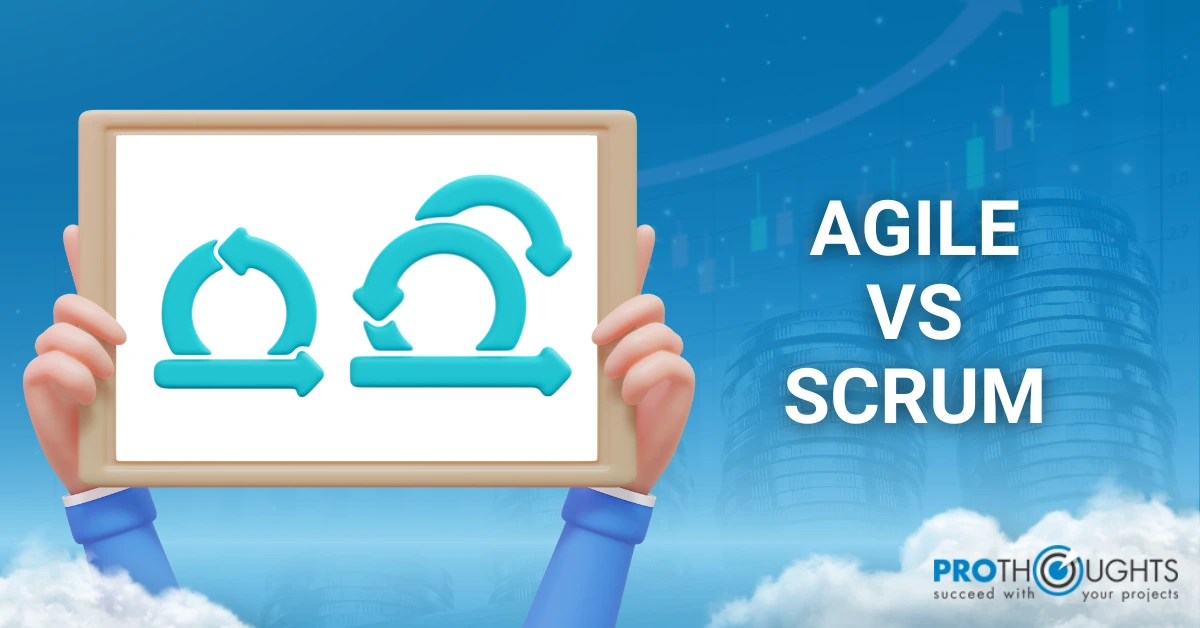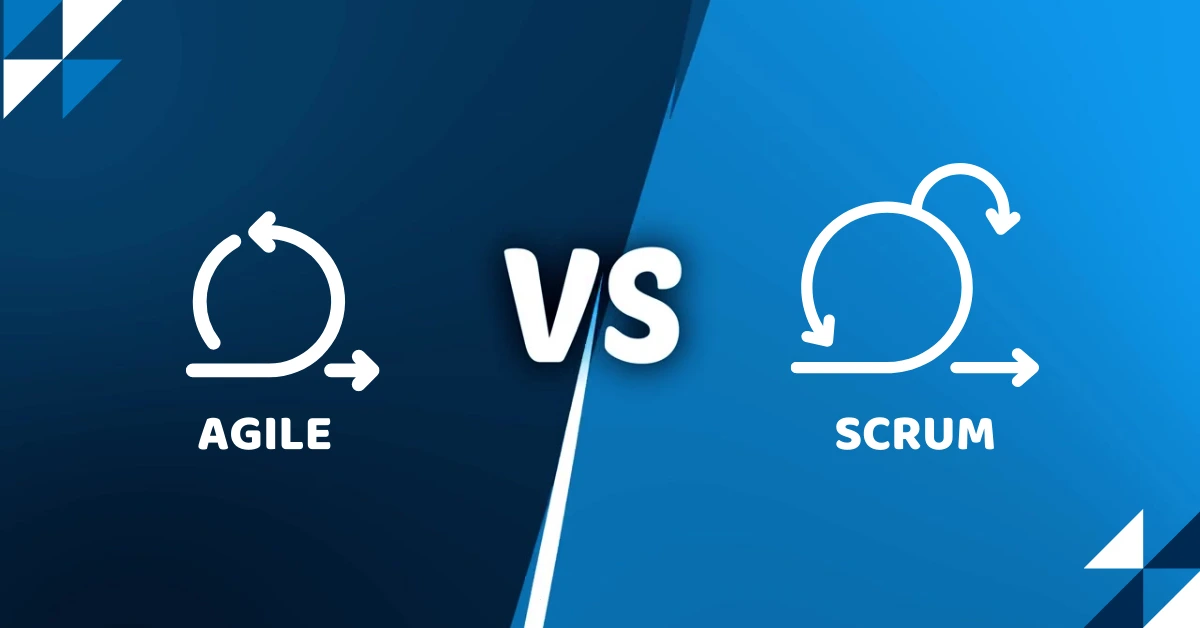To better understand Agile vs Scrum, it’s helpful to know more about how it works. When beginners enter the world of project management, the unfamiliar language and processes they might encounter in this demanding and specialized business may appear frightening. A project manager’s function within a project management team entails oversight of numerous parts of the projects, covering a wide range of responsibilities and tasks. Project managers must build an effective approach for both the planning and execution of the projects under their supervision as they tackle project management. Choosing the suitable project management methodology is important for guiding your efforts and ensuring your project’s success. The two most popular PM approaches used by project managers worldwide are – Agile and Scrum. These two terms almost go hand in hand with one another, and are mostly familiar in the software domain. So, what’s the difference? Let’s find out!
Understanding the Definition: Agile vs Scrum
The Agile Approach
An Agile approach represents a collaborative and adaptable strategy employed by teams to enhance task performance in alignment with management objectives. In contrast to a single, significant revelation or release, Agile methods break down activities into smaller, manageable challenges that can be completed in shorter time frames and delivered regularly. This approach simplifies adaptation to changing priorities, allows for swift responses to emerging challenges, and minimizes costs, time, and inefficiencies associated with these adaptations.
When introducing Agile principles into an organization or project, it’s crucial to implement a structured approach or specific methodology. Agile involves the concurrent execution of development and testing tasks. Additionally, it fosters collaboration and encourages face-to-face communication among team members.
Agile framework is the overarching category encompassing various subsets, such as Scrum. Similar to Scrum, some Agile methodologies like Kanban, Crystal Method, and Extreme Programming also fall under the Agile umbrella.
As to the Project Management Institute (PMI), the Agile approach aims to generate early, measurable ROI through defined, iterative delivery of product features, including providing a basic project version to the client, gathering feedback, and making modifications based on that feedback.
The Scrum Framework
The Scrum framework is an Agile approach to testing that strongly emphasizes collaboration and efficiency. In Scrum-based development projects, the work is organized into sprints, each comprising three key elements: product backlogs, sprint backlogs, and sprint goals. Each sprint defines, develops, and tests a specific function.
Typically, a sprint lasts for two to three weeks, with the exact duration depending on the project’s complexity. Suppose there are any alterations in business requirements necessitating code changes. In that case, identifying and addressing them within the sprint backlog is far more efficient and quicker than going through the entire project development lifecycle as in the waterfall methodology.
Within this organized framework, the scrum master is essential for the project’s success. The scrum master responsibilities keeping the entire team on track, addressing and resolving any issue that arise, maintaining the team complies to scrum practices, and meeting timelines for the project.
What is the Scrum framework? | Prothoughts – YouTube
Agile vs Scrum: Know the Difference
One common misperception is that Scrum is synonymous with Agile. Agile is a wide phrase that encompasses a number of approaches with common fundamental values and ideas. Scrum, on the other hand, is a commonly used Agile framework that provides recommendations on how to optimize work organization for the benefit of end users.
Scrum is primarily stated at the team level in product development; Agile extends its focus to the entire organization, encompassing leadership and company culture.
Numerous organizations combine Scrum with other Agile principles and practices to structure their teams. Even though Scrum might appear relatively straightforward to implement, substantial changes at both the individual and organizational levels. Also, it is necessary to realize Agile’s transformative potential fully.
What is the difference between Agile and Scrum?
Agile is a cooperative and adaptable method which helps in completing tasks, focusing on project management efficiently. Rather than relying on a major launch, agile teams prefer delivering work in manageable, incremental segments. The several agile methodology encompass various widely utilized methods such as Scrum, Kanban, and Extreme Programming.
Scrum is an Agile framework that fosters collaboration and efficiency in project management by employing sprints. It outlines a range of meetings, tools, and roles aimed at optimizing project delivery efficiency.
| Aspect | Agile | Scrum |
|---|---|---|
| Iterative Approach | Agile teams engage in multiple project iterations, structured into a prioritized backlog informed by end-user feedback. | Scrum breaks down projects into more minor phases known as sprints, each featuring product backlogs, sprint backlogs, and sprint goals. |
| Project Flexibility | Agile strongly emphasizes flexibility and adaptability, enabling changes as needed throughout the project. | Scrum is more structured and less flexible, making it ideal for delivering results quickly. |
| Suitable Team Size | Agile is well-suited for smaller teams and individuals who favor simplicity in both design and execution. | Scrum is better aligned with creative and experimental approaches. |
| Relationship | Agile encompasses a broader philosophy regarding the delivery of projects to customers. | Scrum is a particular Agile methodology employed to streamline a project. |
A useful perspective is to consider that Scrum consistently falls under the Agile umbrella, while agile does not always align with Scrum. In other words, Scrum incorporates the core methodologies of Agile, but Agile may not necessarily exhibit all the characteristics of Scrum.
Agile Vs Scrum: Agile key features:
-
Modular Functioning:
Modularity is identified as one of the most important aspects of a successful process. Modularity is the element that permits components to be broken down, and the broken component is known as an activity. The process is simply a series of operations that define or transform the system concept into reality. the Agile process makes use of good tools and is wielded by good craftsmen who are well-known for using them at the correct moment. these cannot be used on the manufacturing line for produce goods.
-
Iteration:
The agile methodology recognizes the need of doing things wrong before getting them right. As a result, agile processes priorities short cycle times. Each cycle includes a task of defining actions that help completing task correctly: these cycle have a time frame of one week from start to finish. The iteration, or single cycle, may or may not result in a 100% accurate element. Because of this, a single brief cycle is repeated numerous times until the desired effect is obtained.
-
Adaptation:
During iterations, there is a higher probability of risks that you have not expect being discovered; the agile strategy is prepare you to cope with these unknown risks. If the functionality produces different results, new activites or functionality might be implemented to achieve the purpose.
-
Collaboration:
The agile process offers a very practical approach to conversations, which are face to face discussions with the client or team members themselves. good communication is essential for the success of projects. When the system is constructed in pieces, the potential of miscommunication increases; therefore, every member must understand how the pieces join together to create a final product. When individual iterations are complete. the process focuses on integration rather than communication. Integrating minor integrations into larger parts developed continuously necessitates with teams to ensure proper integration into the system and delivery of the final result.
Agile Vs Scrum: Scrum key features:
- Sprint Sessions: During project planning, a timeframe is often set for completion, but human tendencies to overestimate or underestimate time can lead to disparities between planners and executors. Scrum addresses this by advocating for sprint sessions, dividing teams into smaller groups of 3-9 individuals working collaboratively for a week or two. The planners, who are also the executors, review the project’s progress weekly and plan the sprint, ensuring continuous engagement and adaptation to the project.
- Show Progress: In large-scale projects with multiple teams, inter-team communication challenges may arise. To boost morale and energy levels, Scrum introduces the practice of creating charts to visually represent everyone’s efforts. This visibility encourages faster progress from slower employee and motivates energetic employee to maintain their pace.
- Burndown Chart: While many organizations use standard progress charts, Scrum introduces the ‘Burndown’ chart weekly. This chart displays available working days against the quantity and pending work. It provides a clear depiction of remaining work and the number of weeks required to complete the assignment, promoting transparency and realistic expectations.
- Precise Meetings: Daily meetings are commonplace in the business sector, often lasting hours with minimal impact. Scrum addresses this with brief daily meetings, lasting no more than 10-15 min.. Instead of delving into extensive project details repeatedly, these meetings focus on three key questions:
- What occurred yesterday? Briefly outline each team’s accomplishments from the previous day.
- What will happen today? Discuss the tasks each team will undertake on that day.
- What will happen the next day? Anticipate potential challenges and strategies solutions for the future, promoting efficiency and problem-solving.
What does the 3 C’s stand for in Agile?
Ron Jeffries claimed the Card, Conversation & Confirmation model to differentiate “social” user stories from “ documentary” needs practices like use cases.
“Card, Conversation, Confirmation” is method of capturing the components of a User Story:
- Card (or Post-it note)- A physical token that gives tangible and effective form to what would otherwise be an abstraction.
- Conversation- This takes place among all the individuals concerned by a given feature of a product: customer, users, developers, testers. However, the discussion is mainly verbal but often infused by documentation.
- Confirmation- In the end a “confirmation,” the more professional the better, that origin.
Agile vs Scrum: Choosing the Right One
When you clearly understand Agile and Scrum and their interaction, you can start thinking about how to apply these methodologies to your projects. However, the decision should revolve around something other than choosing Agile or Scrum. Instead, if you determine that an agile approach is suitable for a specific project, the question becomes: Which agile methodology best fits? This choice may lead you to Scrum, but various other Agile methodologies must be considered. Scrum is typically well-suited for projects characterized by unclear requirements, anticipated changes, and the need for frequent testing.
To determine if Agile fits your project, you must look for the specific requirements and constraints involved. Originally designed for the development of projects, Agile excels in this context but may not be effective for projects with stringent scope and development demands. However, it does fit a wide spectrum of projects.
It is essential to recognize that project success requires not only the selection of the correct approach but also its execution. To accomplish this, you must have a thorough understanding of the chosen methodology as well as other important project management skills. Communication, team leadership, critical thinking, problem-solving, and flexibility to obstacles and organizational issues are all required skills for effective project managers.
Conclusion
Once you’ve a solid understanding of Agile and Scrum and their interplay, you can contemplate their application in your projects. Due to the difference between Agile and Scrum, the decision isn’t merely a choice between the two methodologies.
When you start understanding that an Agile approach will be the best fit for a particular project, the next question is: which Way of Working can we use?, or any of the other Agile methodologies available, might be the answer. Suppose you aspire to build a successful career in Agile and Scrum. PMI’s prestigious DASSM certification would complement your expertise! You can read more about Disciplined Agile Certification on the ProThoughts site.






